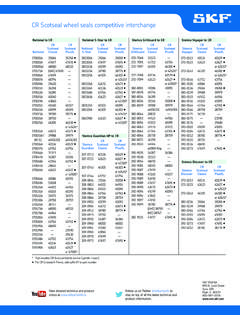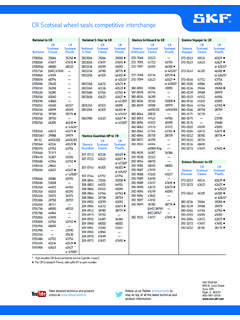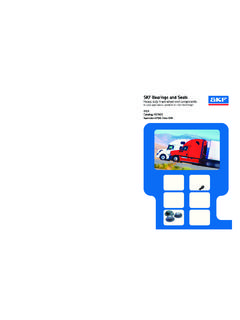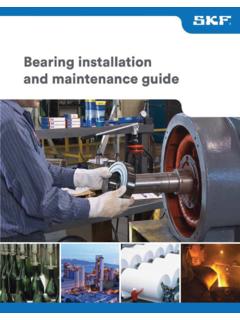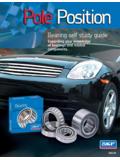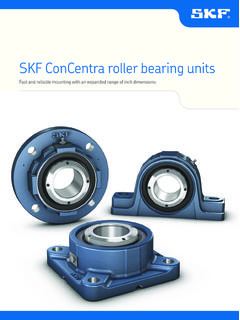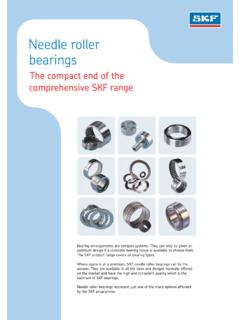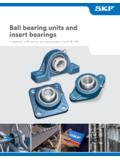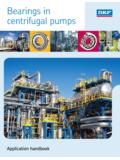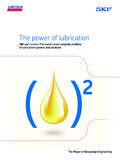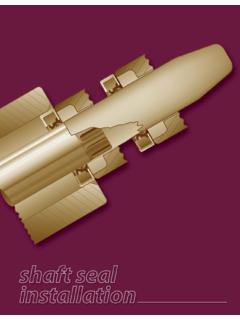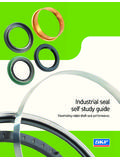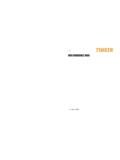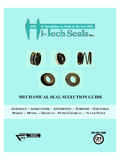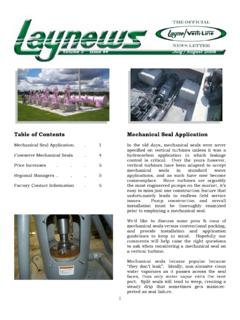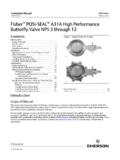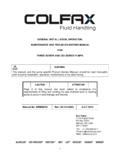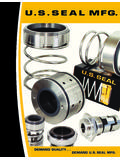Transcription of Wheel end bearing and seal installation guide - …
1 Automotive editionFeaturing front and rear Wheel drive modelsWheel end bearing and seal installation guide2 IntroductionContentsThe SKF seal and bearing lnstallation guide (SKF #457809) covers the removal and installation of SKF seals and bearings on front and rear Wheel drive passenger include: Front axle seals and bearings Rear axle seals and bearings Pinion sealsInstallation instructions also are provided for SKF Speedi-Sleeves uItra thin, stainless steel wear sleeves used to repair scored or seal -worn more informationFor more information on seal and bearing installation and maintenance, ask for these SKF training materials: Roller and Ball Bearings Self Study Program (#457640) Automotive Shaft Seals Self Study Program (#457492) How to Inspect a bearing Poster (#457235) Passenger Car and Light Truck Seals and Bearings Catalog (#457205)To request these materials, or order additional copies of this guide , please write to: SKF 890 N.
2 State Street, Suite 200 Elgin, IL 60123-9332 Attn: Marketing CommunicationsNote: All material has been carefully compiled and thoroughly checked. However, no responsibility for possible errors can be tips for proper bearing and seal maintenance Follow these guidelines whenever replacing seals and improved seal performance: Work with clean tools. Pre lube the seal with the same lubricant being retained. Double check the seal part number before installation . Inspect the shaft and bore for burrs, nicks or other damage before installing a new seal . Never reuse old seals. Never hammer directly on a improved bearing performance: Work with clean tools, in clean surroundings. Keep bearings wrapped until ready to install. Pre lube bearings before installation . Keep bearing lubricants clean and in covered containers when not in use. Remove all outside dirt from housing before exposing bearings.
3 Clean the inside of the housing before replacing bearings. Never spin a bearing with compressed air. Never hammer directly on a bearing . Never mix old and new bearing brake caliper mounting bolts (fig. 1).Pull off dust cover (fig. 2).Tap out old seal and inner bearing (fig. 4).Remove adjusting nut, washer and outer bearing (fig. 3).Front Wheel tapered bearing sets and seals for disc and drum brakesBearing/ seal removal1 . Raise the front end of the car on a hoist, or safe support it on jack stands. Never work on a car supported only by a bumper Remove the hubcap or Wheel cover. Use a wrench or jack handle to take off Wheel lug nuts. Then pull straight back to remove the On disc brake cars, loosen and remove the brake caliper mounting bolts (fig. 1). CAUTION: The brake line does not need to be disconnected, but the caliper must be supported while disconnected to avoid brake line damage.
4 The caliper can usually be rested on the lower A frame or suspended by a wire Using pliers or a screwdriver, remove the dust cover and cotter pin (fig. 2).4. Loosen the adjusting nut. Jerk the rotor or drum assembly to loosen the washer and outer Wheel bearing (brakes may have to be backed off). Push the assembly back on the Remove the adjusting nut, washer and outer Wheel bearing (fig. 3).6. Pull the drum or rotor assembly straight off the spindle. Do not let the inner bearing or seal drag on the spindle With seal side down, lay the rotor or drum on the floor. Place a drift or broom handle against the inner face of the bearing cone. Carefully tap out the old seal and inner bearing (fig. 4).8. Before discarding the seal , record its part number to aid in selecting the correct SKF replacement. Never reuse old seals. Contamination entering past an old seal will ruin a Clean and inspect the old bearing thoroughly before reusing it (see Cleaning and Inspection).
5 CAUTION: If either the cup or cone is damaged, discard the entire bearing and replace it with a new one. Remember to drive the used bearing cup out of the : Never install a new bearing cone with a used bearing cup, or vice Match the part number of the old bearing to select the correct SKF bearing in clean solvent (fig. 5).Compressed air may be used to dry cleaned bearing (fig. 6).Grease bearing (fig. 7).Place inner side of drum or rotor face up (fig. 8).Inspection and cleaningNote: Equipment must conform to OSHA standards. 1. Using a clean solvent and a clean dry cloth, remove oil, grease and dirt from the hub cavity, dust cover and Use a clean brush to remove dust from brake : To avoid inhaling asbestos brake dust, never blow off brake parts with compressed Place the bearing in a metal basket and suspend it in a clean container or tank of solvent. If a basket is not available, suspend the bearing with a wire or place it on a metal plate at the bottom of the container or Rinse the bearing in clean solvent (fig.)
6 5). Dry it thoroughly. Natural air drying is the safest method to use. Compressed air (free of all condensed moisture) may be used to blow out the bearings, but only after dirt has been removed (fig. 6).CAUTION: Never spin a bearing with compressed air. Personal injury may result. Also, never use water or steam to clean or rinse a bearing . Moisture causes corrosion, which results in premature bearing Inspect the cleaned bearing thoroughly for nicks, pitted areas, and damage. If any of these are present, discard the entire bearing and replace it with a new If it will not be reused immediately, dip the cleaned bearing in a protective lubricant or coat the surface with a light grease. Rotate the bearing to work grease thoroughly in and around the rollers and on the races. Wrap the lubricated bearing in waterproof paper and place it in a clean box. 7. Inspect the spindle for burrs, nicks or embedded particles.
7 Carefully smooth out any roughness with an emery : Deep scores or grooves on the shaft surface where the seal makes contact must be repaired before reassembling the Wheel (see SKF Speedi-Sleeves page 16).5 Slide SKF seal onto installation tool (fig. 9).Tap tool until seal is seated in hub (fig. 10).Replace drum or rotor (fig. 11).Install outer bearing (fig. 12). bearing / seal installation1. Be sure the new seal is the correct one for the application. If you are replacing the bearing , the new part number must match the old one. To select part numbers for either bearings or seals, consult the SKF Passenger Car, Light and Medium Truck Seals and Bearings Catalog (SKF #457205).2. By hand or with an SKF bearing repacker PB270, force grease through the cage and rollers or balls and on all surfaces of the bearing (fig. 7).3. Place the inner side of the drum or rotor face up. If you are replacing the bearing cup, use the proper tool to drive the new cup into the hub (fig.)
8 8).4. Coat the hub cavity with the same Wheel bearing grease, to the depth of the bearing cup s smallest diameter. Apply a light coat of grease to the Place the inner bearing in the hub. Lightly coat the lip of the new SKF seal with the same Wheel bearing Slide the seal onto the proper SKF installation tool. The seal should fit over the tool s adaptor, and the sealing Iip should point toward the bearing (fig. 9).7. Position the seal so it starts squarely in the hub without cocking. Tap the tool until the seal bottoms out. When the sound of the striking mallet changes, the seal will be fully seated in the hub (fig. 10).8. If an installation tool is unavailable, use a wood block and hammer to drive in the seal . Never hammer directly on the seal . Be careful not to cock the Wheel reassembly 1. Carefully Iift and push the drum or rotor assembly onto the spindle. Keep the drum or rotor centered, so the seal is not touched or damaged by the spindle threads.
9 Push the drum or rotor back until the seal is seated on the spindle s seal surface (fig. 11).2. Install the outer bearing cone, washer and adjusting nut in that order (fig. 12).3. Replace the caliper on disc brake equipped Replace the Wheel . Replace lug nuts and tighten differential pinion shaft locking bolt (fig. 13).Remove C-Lock (fig. 14). bearing adjustment5. Rotate the Wheel to be sure the brakes are not dragging. Dragging brakes will cause a false Adjust the bearing to manufacturer s recommended setting. If this information is not available, follow these guidelines. While rotating the Wheel , tighten the adjusting nut until there is a slight bind and all bearing surfaces are in Back off the adjusting nut 1/16 to 1/8 turn, or to the nearest locking hole, or enough so that the Wheel rotates freely with .001" to .010" end Insert and bend the cotter pin. Replace the dust Torque lug nuts to manufacturer s recommended Lower the car Replace the Wheel cover or hub Wheel bearings and seals for disc and drum brakesNote: Before starting any removal procedures, determine if the axle shafts are held in place by C shaped locks at the inner end, or by a retainer plate bolted to the axle housing.
10 Then follow the steps below appropriate to C lock or non C lock type of axle shaft. If unsure, remove the differential carrier removal1. Raise the rear end of the car on a hoist or support it on jack stands. Both rear wheels must be elevated. Do not work on cars supported only by bumper Remove the hub cap or Wheel cover. Use a wrench or jack handle to take off Wheel lug nuts. Pull straight back to remove the Detach any retaining clips or bolts holding brake drums to axle shaft flanges. Remove brake : Brake adjustment may have to be backed off. Emergency brake must be Brush dirt from the brake drum 7 Pry out seal (fig. 15).Remove nuts holding retainer plate (fig. 16).plate (fig. 16).Grip axle shaft flange with a slide hammer (fig. 17).Slide off retainer (fig. 18).C-Lock axles5. Place a container or pan under the differential and remove the differential carrier cover. Allow the rear axle lubricant to Loosen the differential pinion shaft locking bolt.
